Iowa’s location along the Mississippi and Missouri Rivers makes certain parts of the state great for observing numerous duck species, especially during peak migration periods.
The state of Iowa is generally farm country, with about 30 million acres of farmland comprising almost 90 percent of the state, according to the Des Moines Register.
But two borders of the state are formed by the Mississippi River and Missouri River and their drainage basins still provide habitat for wildlife such as ducks.
Iowa isn’t known for its wetlands and lakes, but they’re still there. According to a 2019 report from Radio Iowa, about 65 percent of the lakes in Iowa are man-made, not natural. That doesn’t mean that they don’t provide adequate duck habitat.
Whether you’re out boating on the lake or bird watching on the Mighty Mississippi, here are 20 examples of the duck species you can expect to see in the Hawkeye State.
For a look at some of the other magnificent birds in Iowa, click here.
This is by no means an extensive list, but it’s a good place to start. All measurements are via the Cornell Lab of Ornithology’s All About Birds, a fantastic resource for North American bird lovers.
Surface Feeding Ducks
Mallard
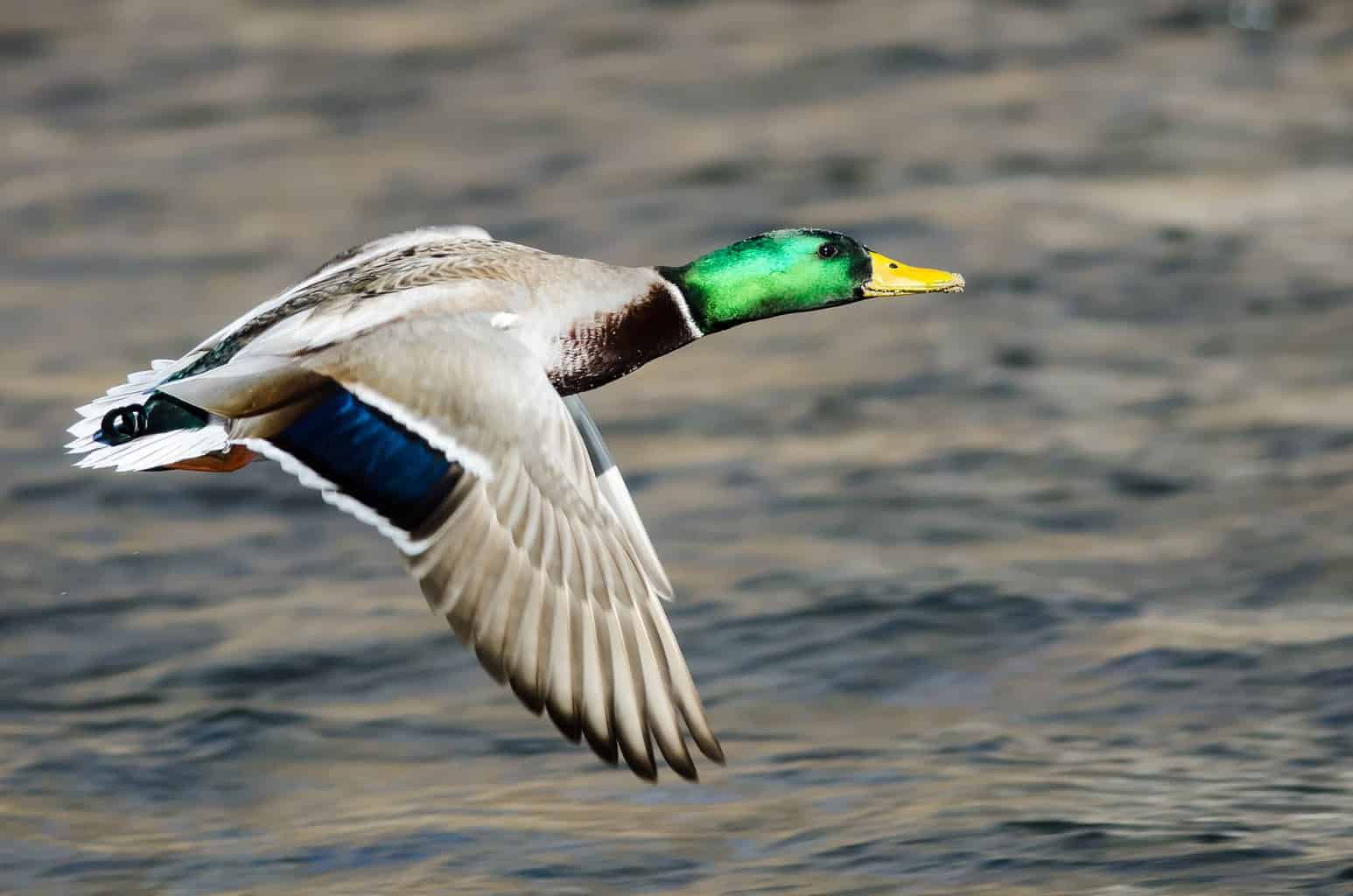
- Anas Platyrhynchos
- Length: 19.7-25.6 inches
- Weight: 35.3-45.9 ounces
- Wingspan: 32.3-37.4 inches
The mallard is one of the most common and easily recognizable ducks across the United States and the state of Iowa.
Mallards are medium-sized ducks that can handle a variety of habitats, and can often be found just about anywhere, from lakes and rivers to popular human areas, such as city parks and backyards.
Males are identified by their metallic green heads and contrasting yellow bills.
Females lack the green head and appear similar to other surface-feeding ducks in the Anas genus. Look for a dull orange bill with black markings, occasionally covering much of the bill.
Northern Shoveler
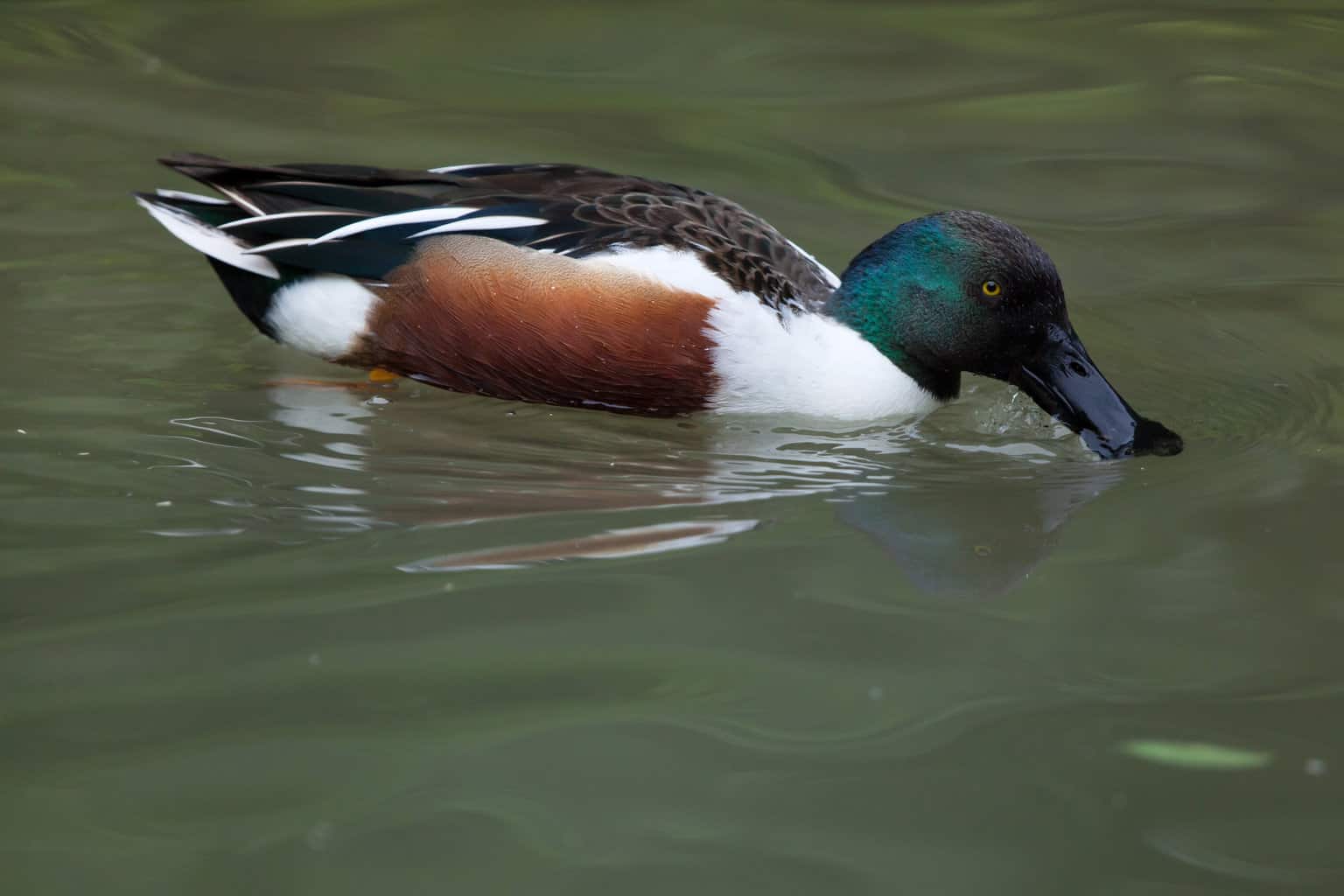
- Spatula Clypeata
- Length: 17.3-20.1 inches
- Weight: 14.1-28.9 ounces
- Wingspan: 27.2-33.1 inches
Male northern shovelers have a green head similar to a mallard, but their black bill is much wider and longer than that of a mallard. Against the smaller shoveler’s body, it’s hard to miss.
Look for the rusty brown underside against a white body as well when identifying a male shoveler.
Female shovelers have a similar color to mallard females, with an orange and black bill, although, like the male, it’s much larger than that of a mallard.
You’ll usually find shovelers in marshes and wetlands, using those large bills to find their favorite food.
American Black Duck
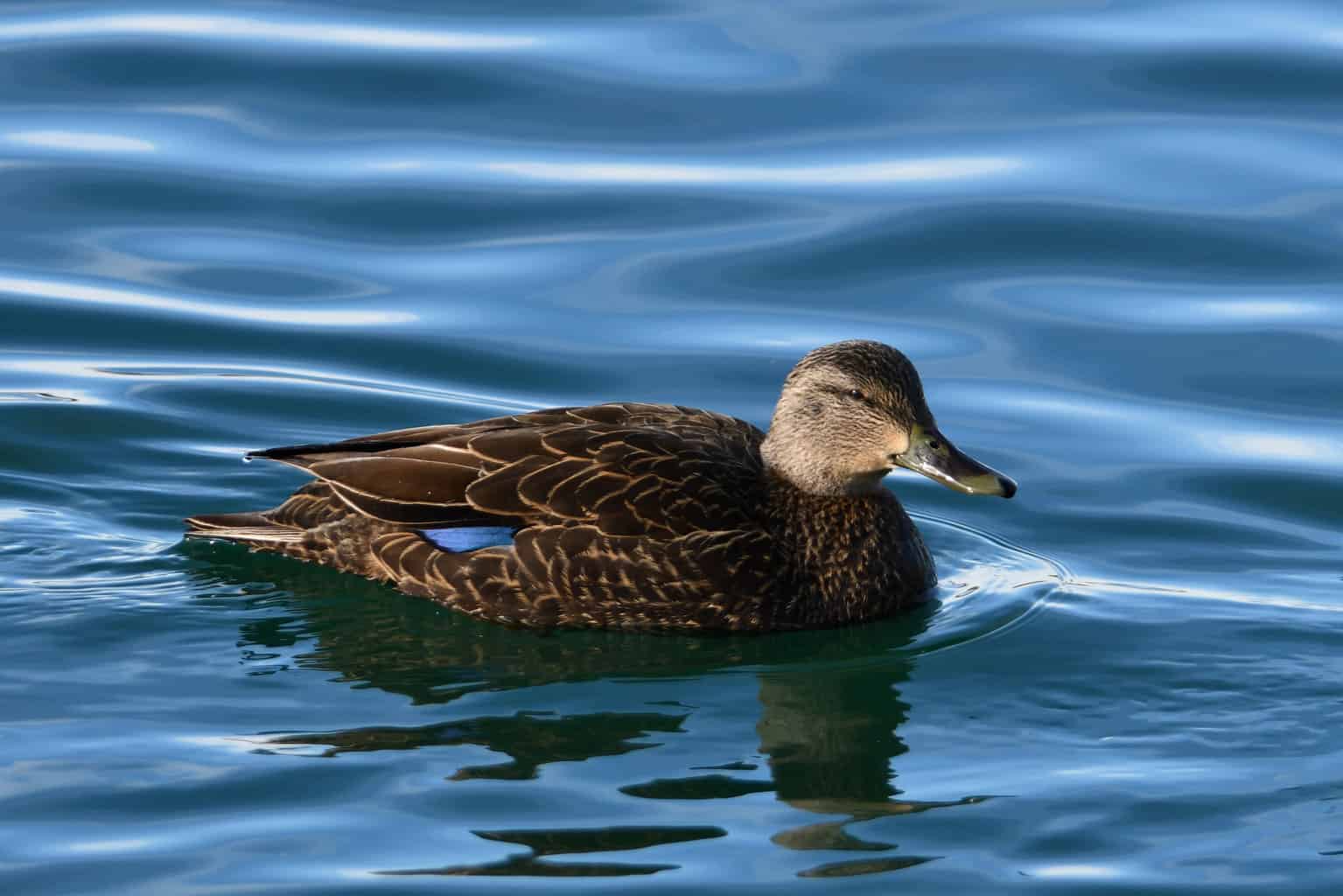
- Anas Rubripes
- Length: 21.3-23.2 inches
- Weight: 25.4-57.9 ounces
- Wingspan: 34.6-37.4 inches
American black ducks have dark bodies with a very similar shape and size to a mallard, frequently hybridizing with mallards in certain parts of their range.
According to the Canadian Wildlife Federation, about five percent of birds that look like black ducks across North America are actually hybrids. This number can be higher in local concentrations.
Males lack the green head that mallards have and females have a dull olive-colored bill that can differentiate them from a mallard.
These mostly eastern birds aren’t common to much of Iowa but may sometimes be seen wintering in areas near the Missouri and Mississippi rivers.
Gadwall
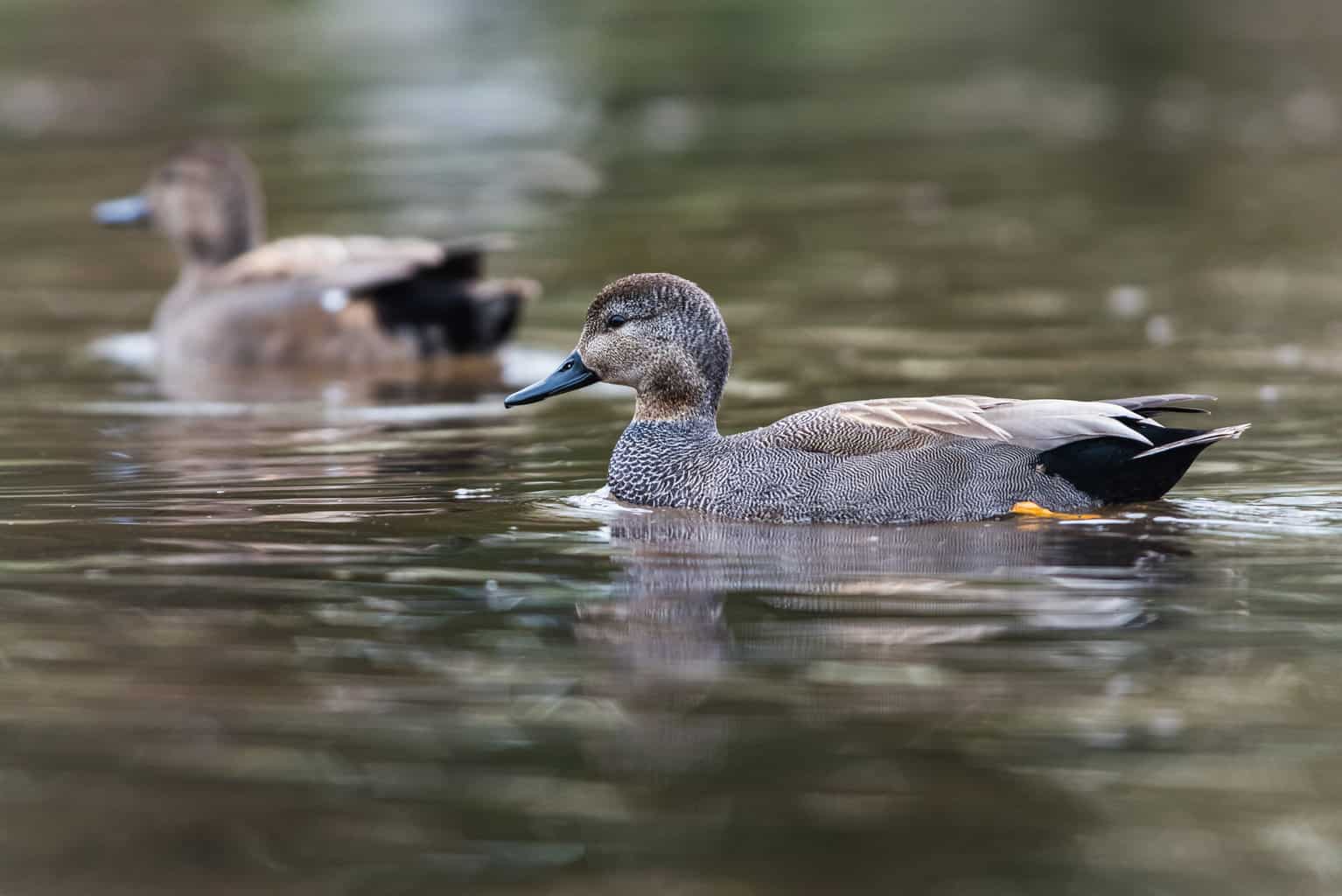
- Mareca Strepera
- Length: 18.1-22.4 inches
- Weight: 17.6-44.1 ounces
- Wingspan: 33.1 inches
The female gadwall looks almost like a carbon copy of the female mallard. The Cornell Lab of Ornithology says that gadwall females have a thinner, darker bill, but without a reference point to a mallard, this can be very difficult to see while afield.
What the females do lack is the colored patch on their wings that is sometimes visible on female mallards. Gadwall females instead have a white patch.
Males have black bills, brown heads, and gray-brown bodies that come to a black point at the tail. Like females, they have a white wing patch visible while in the air.
Gadwall breed in the western Great Plains and are more widespread throughout the year in areas west of the Rockies. You’re most likely to catch a glimpse of a gadwall in Iowa during heavy migration periods.
Take Saylorville Reservoir in Oak Grove Recreation Area just outside Des Moines, for example.
Birders on eBird have reported numerous gadwall in March and April, only for there to be no sightings again until October and November, when they start to pick up again before disappearing until next spring.
Blue-winged Teal
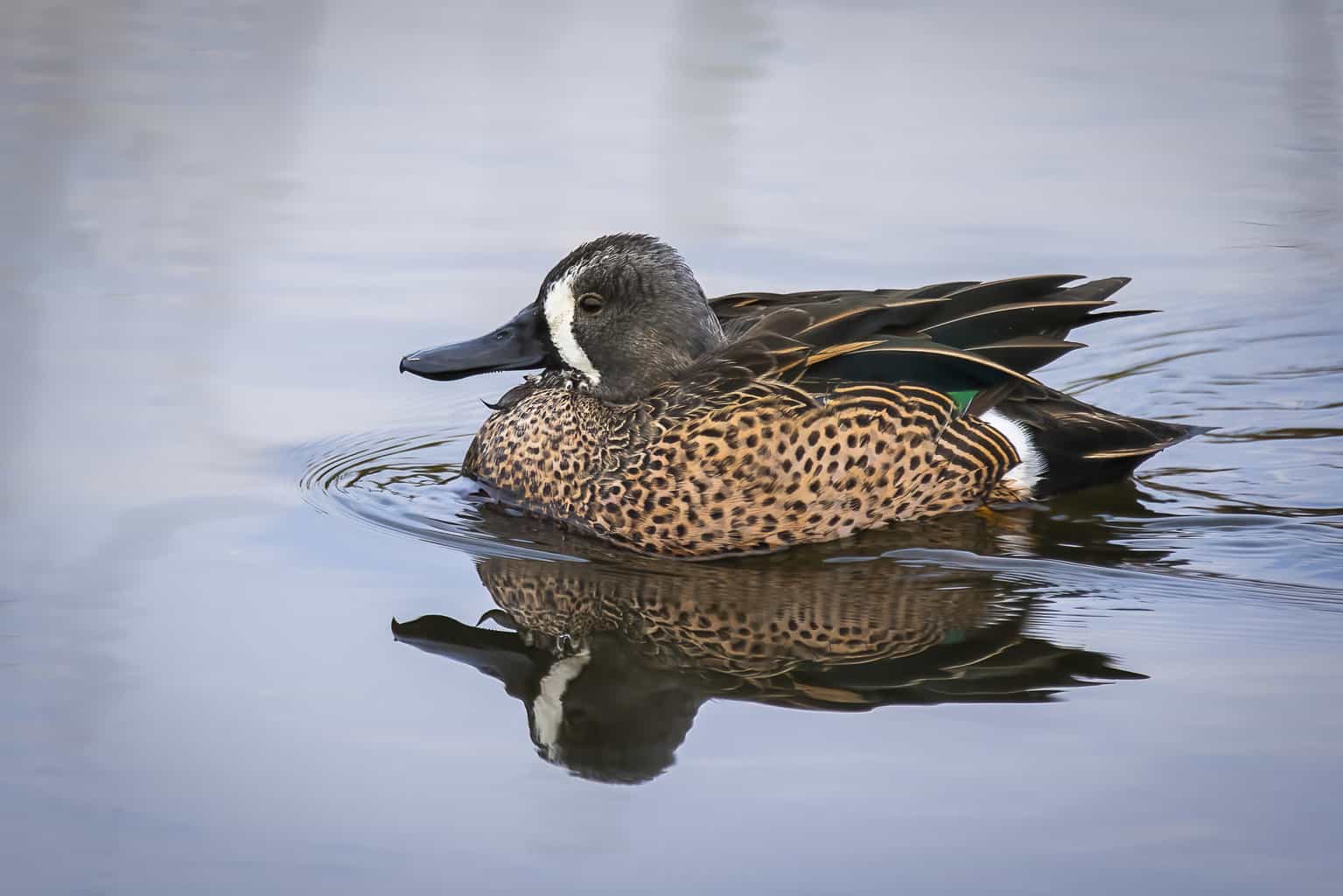
- Spatula Discors
- Length: 14.2-16.1 inches
- Weight: 8.1-19.2 ounces
- Wingspan: 22.1-24.4 inches
These small surface feeders are common in marshes, shallow ponds, and wetlands, with the core of their range in the northern prairies of central North America, according to Ducks Unlimited.
Male blue-winged teal are striking birds with gray heads and a crescent white strip along their faces. They have a dark gray bill and a lightly-colored, speckled side.
Females have brown bodies and dark bills. Both sexes reveal a powder-blue shoulder patch when in flight.
Green-winged Teal
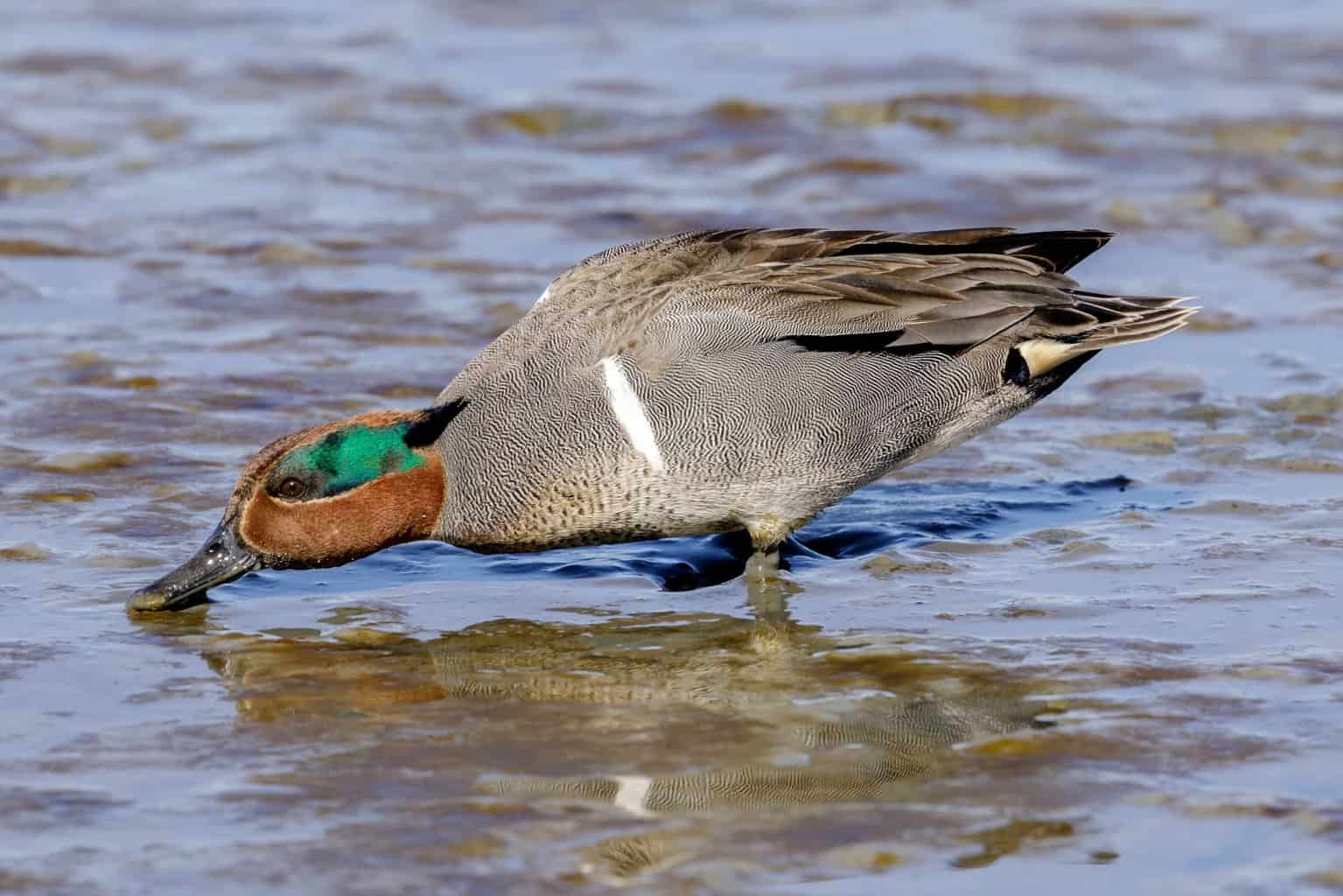
- Anas Crecca
- Length: 12.2-15.3 inches
- Weight: 4.9-17.6 ounces
- Wingspan: 20.5-23.2 inches
The green-winged teal is North America’s smallest dabbling duck, according to the National Geographic Field Guide to the Birds of North America.
Males sport a chestnut-brown head with a green patch that extends from the back of their head to their eye surrounded by a thin white border. Females are small, with proportionately small bills and brown bodies.
The green wing patches of both sexes, like with the blue-winged teal, are most easily visible when in flight.
As far as habitat goes, Ducks Unlimited says that green-winged teal prefer “shallow, permanent ponds near boreal forests that boast an abundance of emergent vegetation,” although also nest in pothole country.
The latter is more like Iowa than the former, so if you’re out searching for ducks, those potholes may contain resident breeding green-winged teal. Otherwise, keep an eye out as they pass through during migration.
American Wigeon

- Mareca Americana
- Length: 16.5-23.2 inches
- Weight: 19.1-46.9 ounces
- Wingspan: 33.1 inches
Speaking of green eye/head patches, next up is the American wigeon. Breeding males have a striking green patch on the side of their heads that contrasts with the white top of their heads and lightly-colored bills capped in black.
Females have brown bodies, gray-ish heads, and a black patch around their eyes that almost makes the eye appear as though it’s sunken in. The bill is lightly colored with a black end, similar to that of the male.
The wigeon is a species that Iowans may see on its way through to northern breeding grounds or south in the winter, but they aren’t a common Iowa species all year-round.
Some of the most common areas for wigeon sightings in the state are along its eastern border of Wisconsin along the Mississippi River, according to eBird reports.
Wood Duck
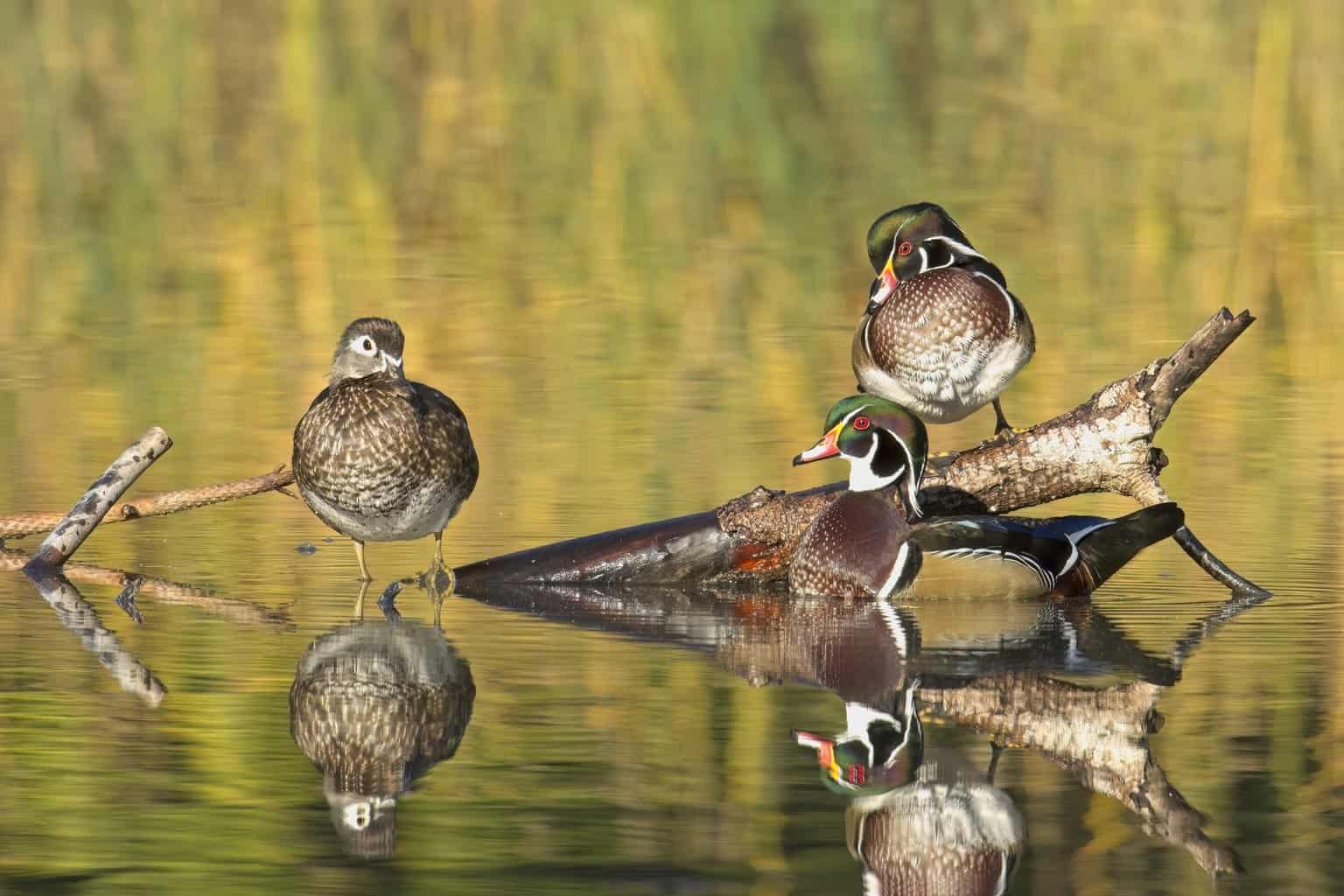
- Aix Sponsa
- Length: 18.5-21.3 inches
- Weight: 16-30.4 ounces
- Wingspan: 26-28.7 inches
After detailing a few difficult-to-identify ducks, we arrive at the uniquely-shaped wood duck.
This colorful bird (in its male form, at least) is unmistakable among its peers if you get a good look at its shape, which includes a green head crest contrasted with a rich brown chest and crisp white markings on its neck.
Females aren’t so bold color-wise, but they still have the identifiable head crest. A white patch around the eye contrasts with the female’s gray head, which meets a brown body at the neck. Blue and white coloring on the wings may also be visible in flight.
Wood ducks may be year-round residents across Iowa. These birds are cavity nesters, meaning they lay their eggs in tree cavities. They require wooded areas near water for their habitat, and they’re known to use nest boxes when provided near the water’s edge.
Northern Pintail
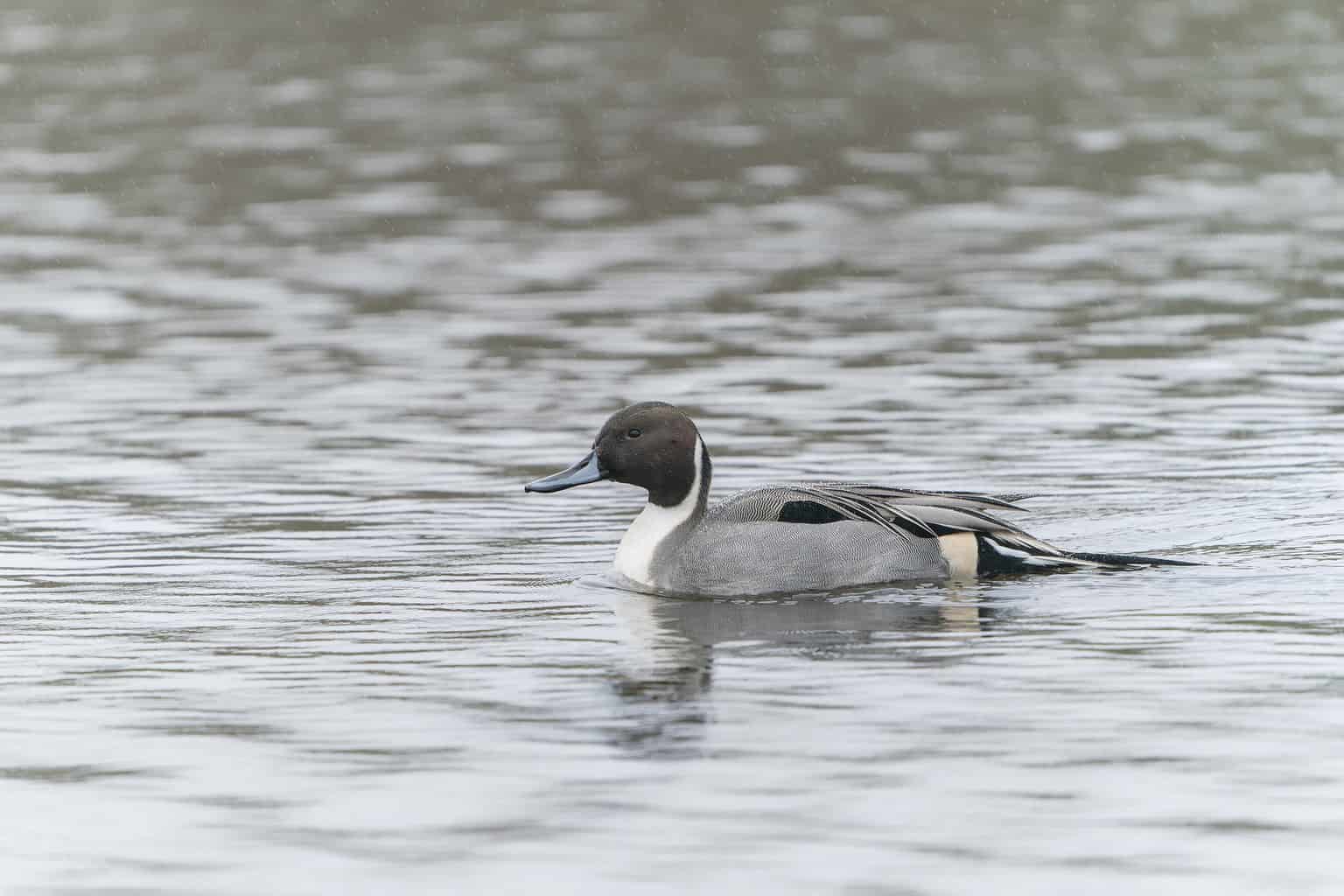
- Anas Acuta
- Length: 20.1-29.9 inches
- Weight: 17.6-51.1 ounces
- Wingspan: 34 inches
Speaking of uniquely-shaped ducks, our list comes to the northern pintail, which features a long, slender, black tail that sticks straight out.
Males have a long white neck that meets a chocolatey brown head on one end and a sleek gray body on the other.
It’s hard to miss a pintail male in the field. Females, on the other hand, are not so easy from afar, but they still have a few characteristics that set them apart from other similar species.
They still have a proportionately longer tail than many other birds on the list, and their neck is clearly longer than a mallard or American black duck, for example.
Pintails are more heavily concentrated breeders in states like North and South Dakota. Iowa is more of a stopover on their way there or while heading south to breeding ranges, so be on the lookout during migration periods.
Like many other ducks on this list, the major stopover spots like the Mississippi or Missouri rivers are often your best bets in the Hawkeye State.
Diving Ducks
Redhead
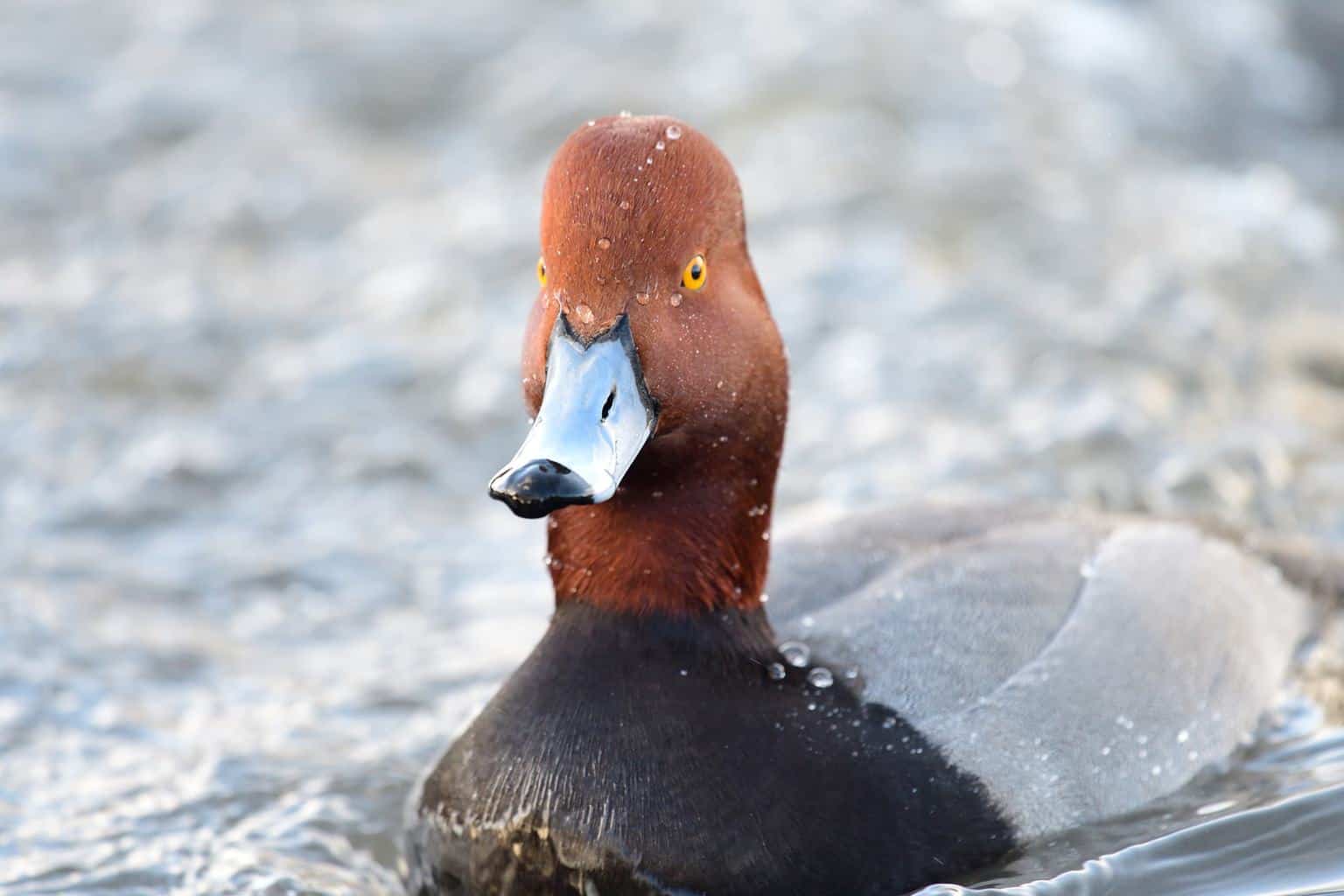
- Aythya Americana
- Length: 16.5-21.3 inches
- Weight: 22.2-52.9 ounces
- Wingspan: 29.5-31.1 inches
Redhead males sport a bronzed red head, a black chest, and a mostly gray body that turns black toward the rear.
Their gray bill ends with a black point and meets their head at a steeply vertical forehead. This will be important when comparing the male redhead to the next duck on this list.
Like most other birds on this list, the female redhead does not have the male’s signature look, instead displaying a light brown body with a darker brown head and a gray, black-tipped bill.
Redhead ducks form large groups during migration and in the winter. Around the new year in 2023, as many as 25,000 Redheads were spotted near the Mackinac Straits off the Michigan shore, for example.
Redheads are more commonly spotted in the Dakotas than in Iowa, but you may still spot these ducks at any time of year in wetlands and lakes, with a higher density during migration time.
Canvasback
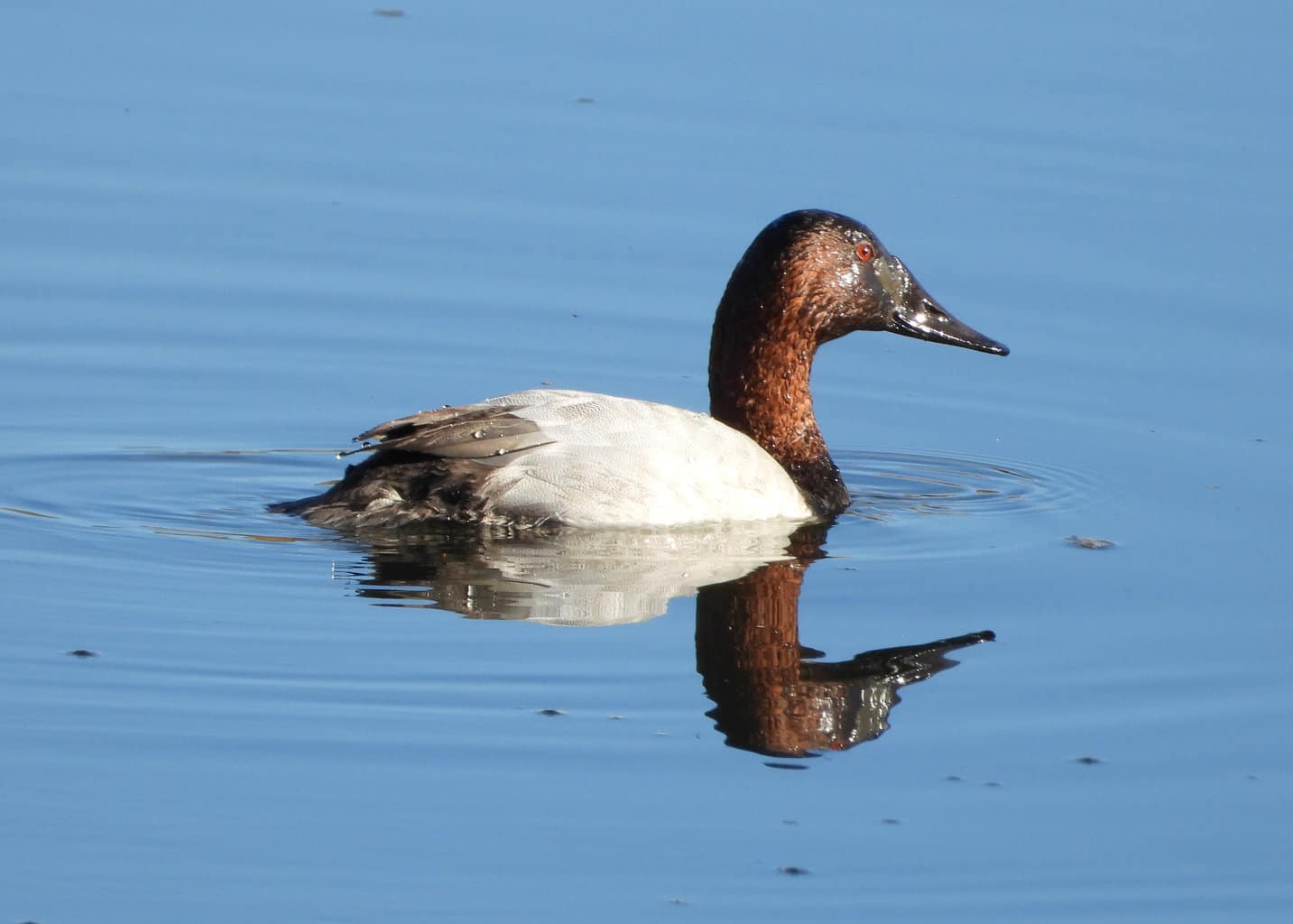
Now, back to what we said earlier about the Redhead’s forehead. While the redhead has a steep slope of the head, a canvasback male has a more gradually sloping forehead that meets a slender black beak.
Canvasback males can also be distinguished from redheads by their white back, contrasted with the gray back of a redhead. Males have red eyes as well, while redhead males’ eyes are orange.
Female canvasbacks have a similar pattern as the male, just with more muted colors. Their backs and sides are a pale gray, with a gray chest where the black spot is on males and a lighter brown head and neck.
Canvasbacks mostly breed up through the northwestern United States and Canada, even as far as Alaska.
Your best bet to see a Canvasback in Iowa is along the state’s western border during the winter, as groups may spend the cold season on the Mississippi River.
Greater Scaup
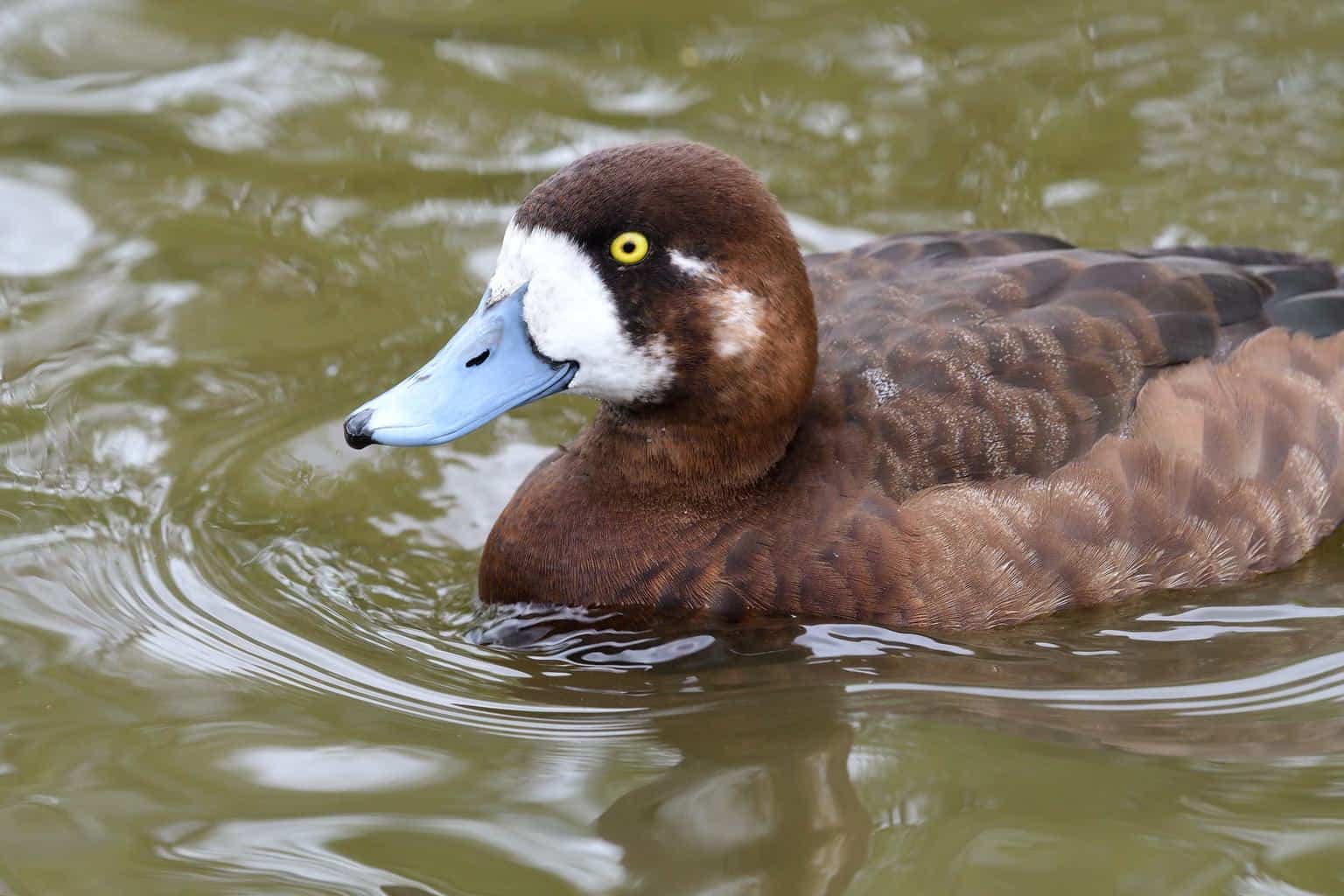
- Aythya Marila
- Length: 15.3-22.1 inches
- Weight: 25.6-48 ounces
- Wingspan: 28.4-31.1 inches
The greater scaup breeds almost exclusively in latitudes of the Hudson Bay and northward, but they migrate long distances each year, at which times you might catch a glimpse of one of their potentially massive conglomerates.
Scaup are rare in Iowa. You’re far more likely to see one on the Great Lakes if you’re able to make a trip a couple of states east.
The iridescent green heads of these deep divers are more likely to look black in typical lighting, with gray backs and white sides. Females are brown with a white patch around their bill. Both sexes have yellow eyes.
Lesser Scaup
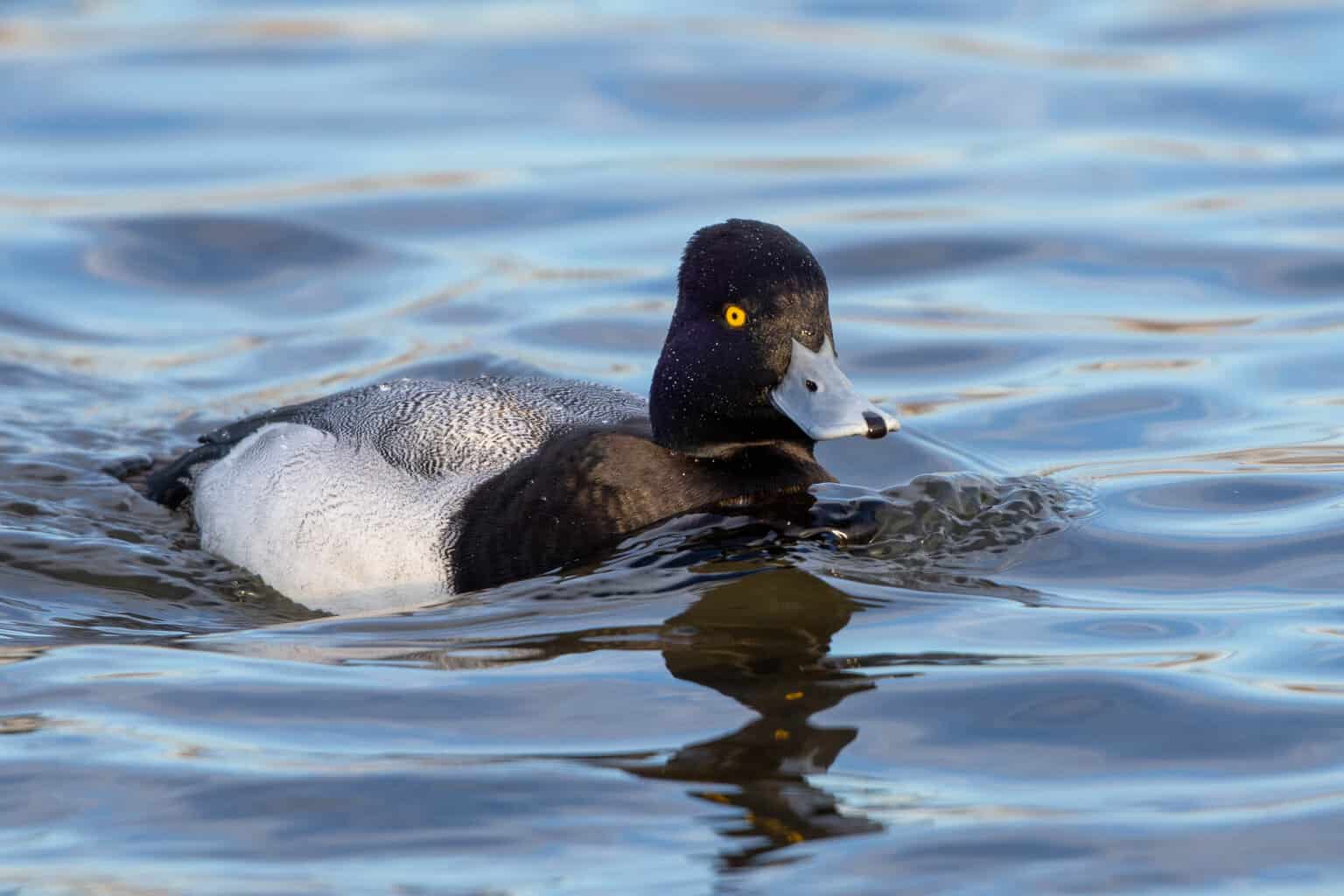
- Aythya Affinis
- Length: 15.3-18.1 inches
- Weight: 16-38.4 ounces
- Wingspan: 26.8-30.7 inches
Lesser scaup and greater scaup are fairly difficult birds to distinguish between while in the field.
Both females and males are quite difficult to tell from the other species. Females are similar brown colors, while males look almost exactly the same.
Lesser scaup are smaller, on average, with a less rounded head. The back of their head slopes downward in a more straight fashion compared to the more rounded noggin of the greater scaup.
When in the field, this often doesn’t help you identify the birds on the spot, unfortunately, unless you have a reference guide and a telephoto camera lens or spotting scope.
Lesser scaup are more common than greater scaup in Iowa, though they’re also most likely to be seen during migration periods. Look for them in groups along rivers and lakes.
Ring-necked Duck
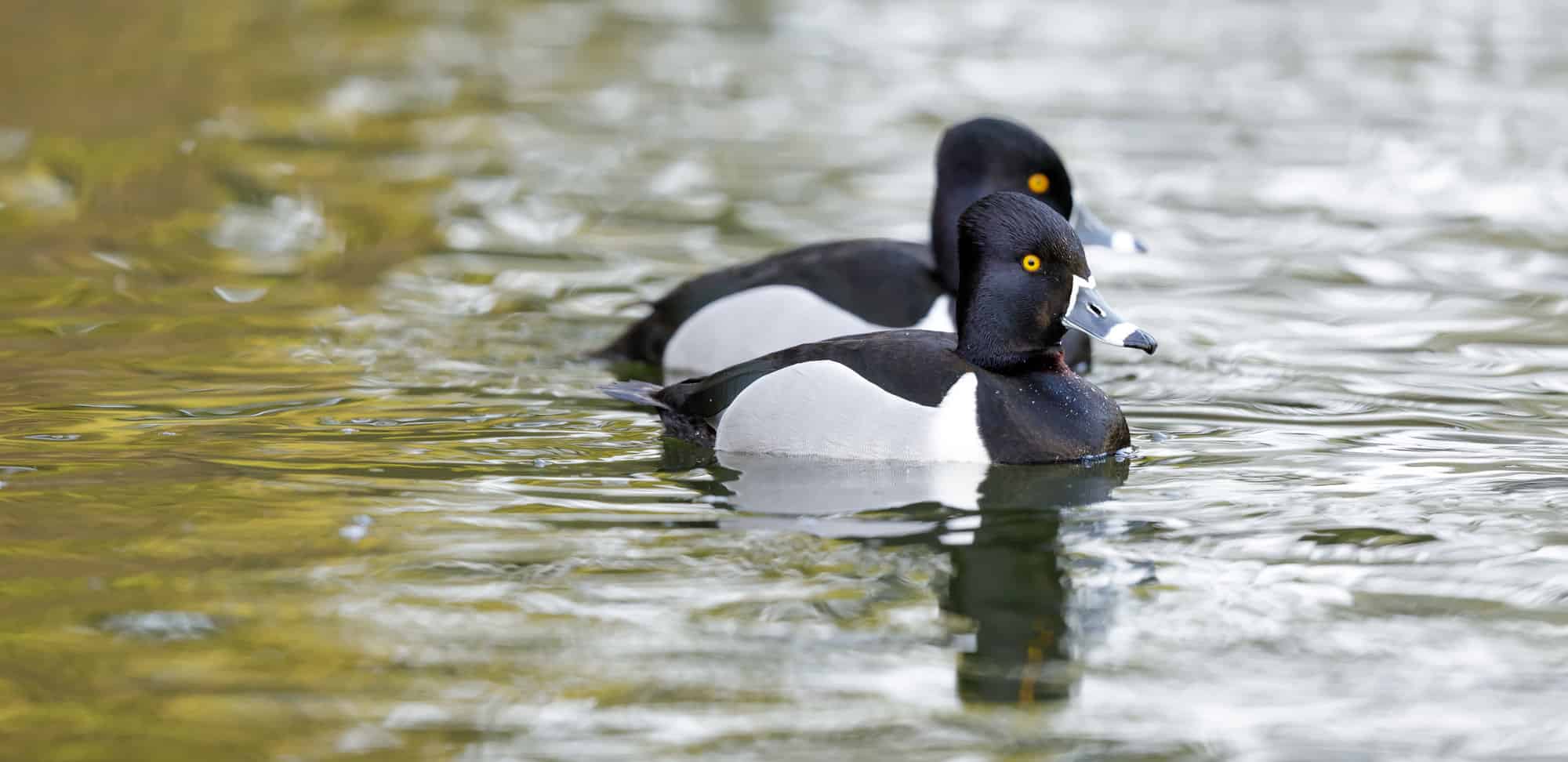
- Aythya Collaris
- Length: 15.3-18.1 inches
- Weight: 17.3-32.1 ounces
- Wingspan: 24.4-24.8 inches
Ring-necked males are a similar color and shape to scaup, but with a black back where the scaup’s back would be gray. Both males and females also have a white ring around their bill that is not present on scaup.
And if you didn’t already have a hard time telling them apart, they may sometimes flock with scaup, according to the Cornell Lab of Ornithology’s All About Birds.
You’re most likely to see ring-necked ducks on smaller bodies of water like wetlands or small lakes than on some of the big rivers where you’d find scaup or other migrating ducks.
Iowa is primarily a migration stopover for these expert diving ducks.
Bufflehead
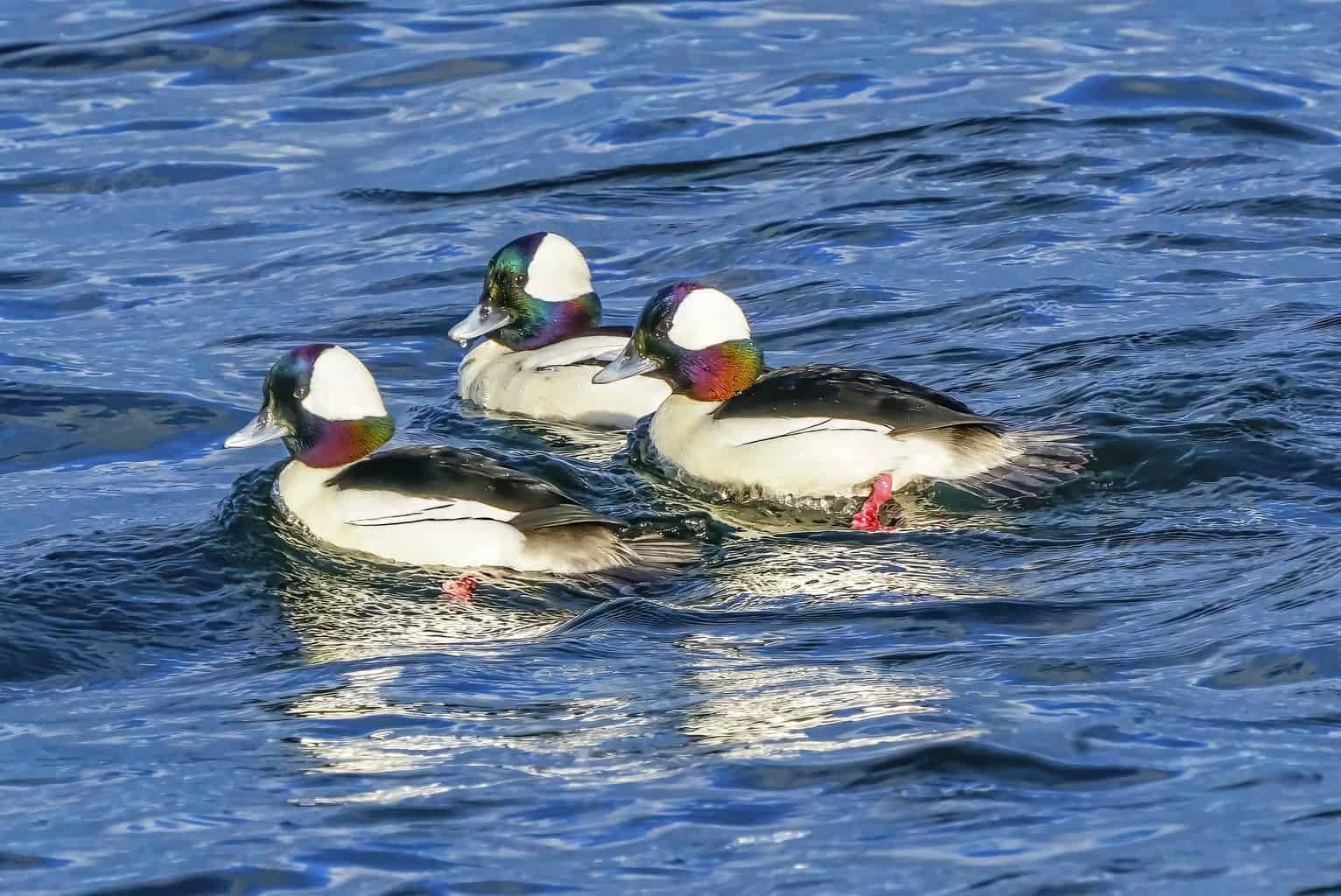
- Bucephala Albeola
- Length: 12.6-15.8 inches
- Weight: 9.6-22.4 ounces
- Wingspan: 21.6 inches
The male of these little divers is easily ID’d by its size and color pattern.
They have white undersides and a white back of the head that almost reaches their eye and splits at a 90-degree angle. The rest of the head is filled in with an iridescent purple-green color.
Females and immature males have more muted colors and a white patch on the cheek.
The only duck with a white patch that rivals the male bufflehead is perhaps the hooded merganser, which has a long, thin, black bill, brown sides, and a big crest on the back of the head that makes them look almost disproportionate.
Female hooded mergansers have a similarly-shaped crest to the males but without the white coloring. They do not have a white facial patch like female buffleheads.
Buffleheads are a rare winter and migration stopover bird for most of Iowa. They’re most likely to be seen ducking under the water in search of their food, quickly popping back up in another location nearby.
Common Goldeneye
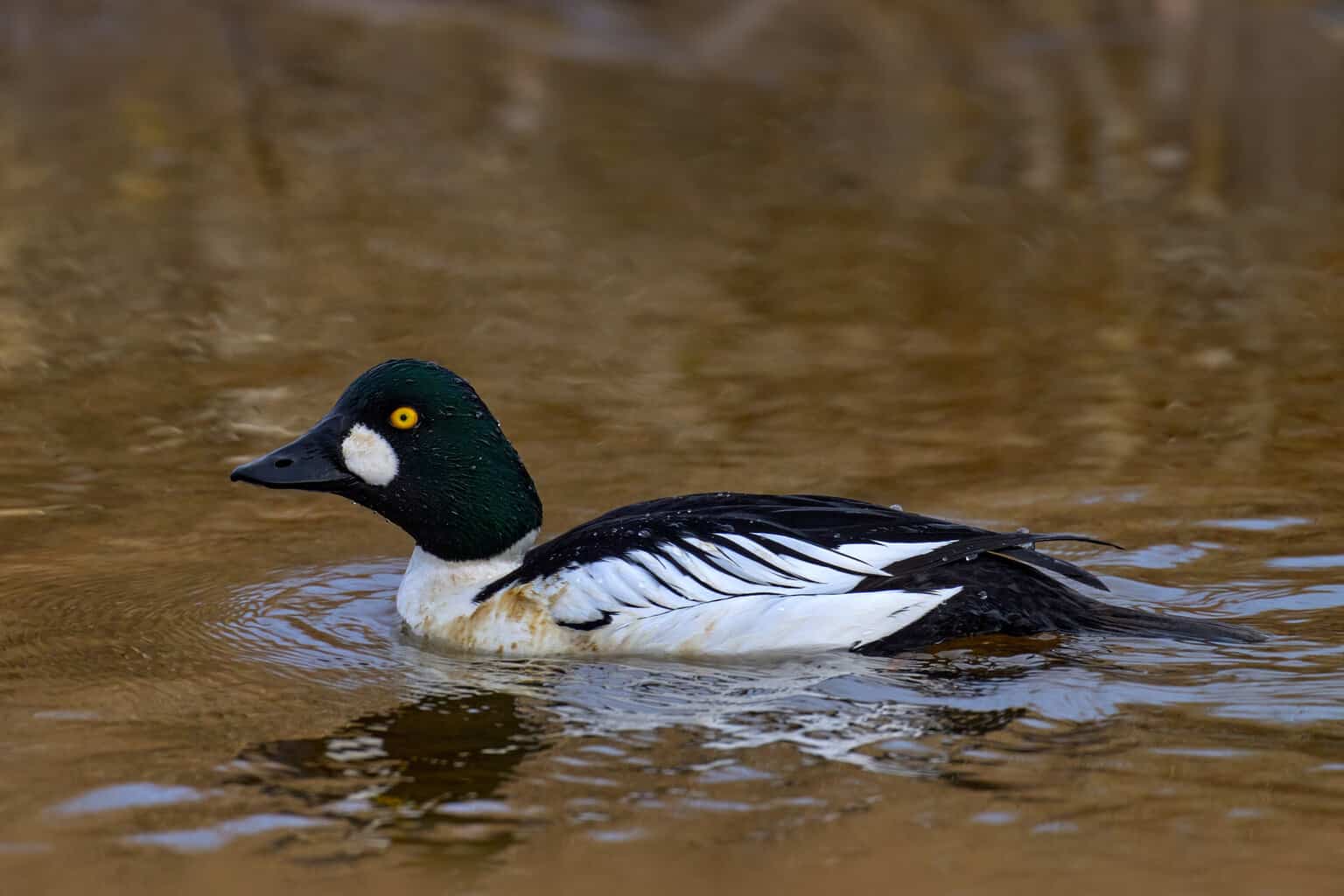
- Bucephala Clangula
- Length: 15.8-20.1 inches
- Weight: 21.2-45.9 ounces
- Wingspan: 30.3-32.7 inches
The common goldeneye isn’t so common in much of Iowa, but where they’re present, it’s often in huge groups.
From January to early March, birders along the Mississippi River report groups of hundreds of goldeneyes on eBird, often near the border of Davenport and Rock Island, Illinois.
Males have an iridescent green head with an oval-shaped white patch near a black beak. A white neck and underside meet a black topside with a white slotted side.
Both males and females have golden eyes, as described by their name. Females have brown heads and gray bodies. When in flight, you may be able to see their orange feet and white wing coloration.
Ruddy Duck
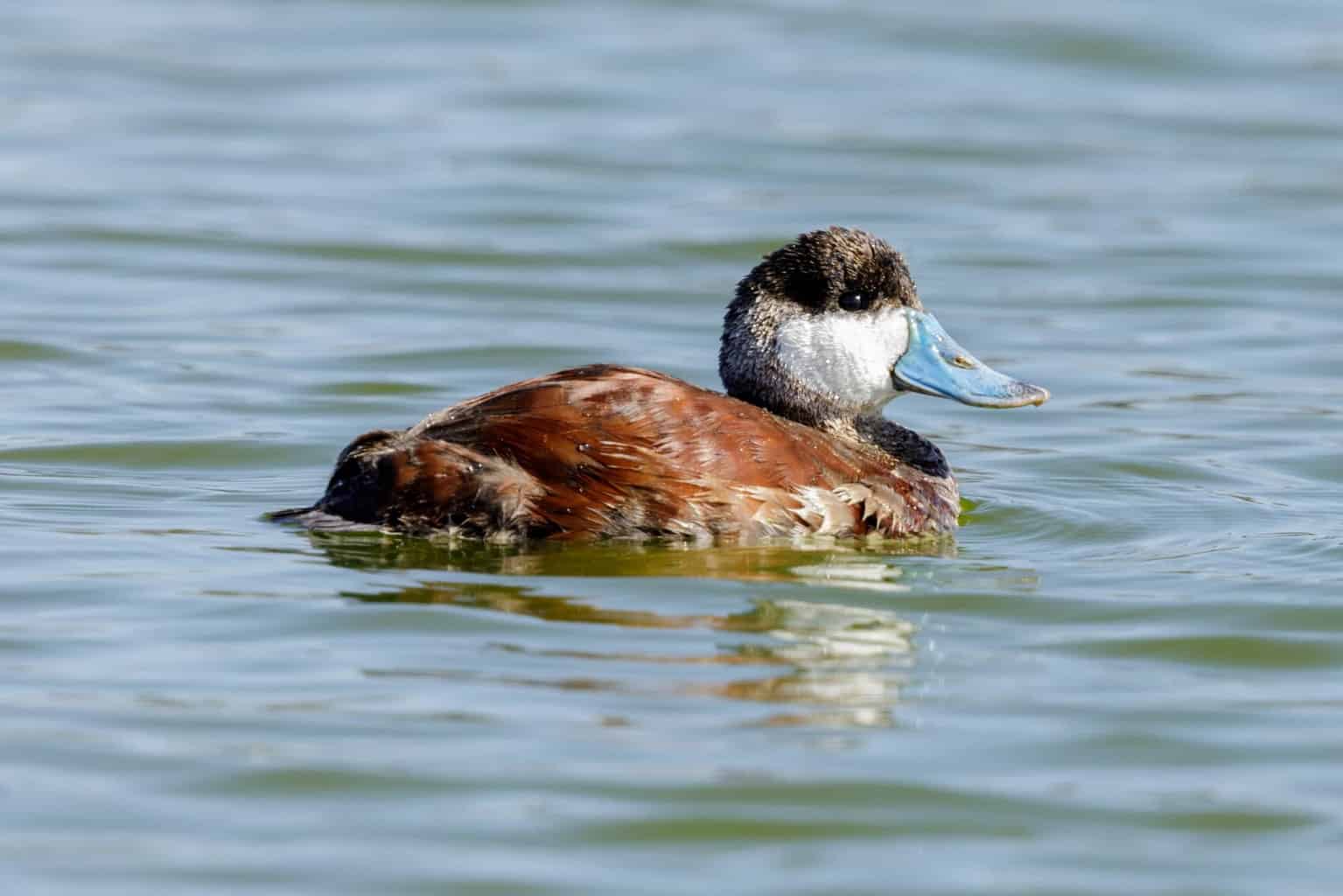
- Oxyura Jamaicensis
- Length: 13.8-16.9 inches
- Weight: 10.6-30 ounces
- Wingspan: 22.1-24.4 inches
Male ruddy ducks are known for their baby blue beaks. They have a white and black head split almost 50/50 and a warm brown body that ends in a long, black tail.
Females have black beaks with light brown bodies. Their head cap is chocolate brown, with a parallel darker streak running below the eye.
Ruddy ducks winter mostly in the Atlantic and Gulf states and nest in the American west, including the Dakotas, Nebraska, and Colorado, and up through western Canada.
The western edge of their breeding range just clips western Iowa. They’ve been commonly reported by eBird birders in places like Big Spirit Lake, Trumbull Lake, and Lost Island Lake in recent years, to name a few.
Mergansers
Common Merganser
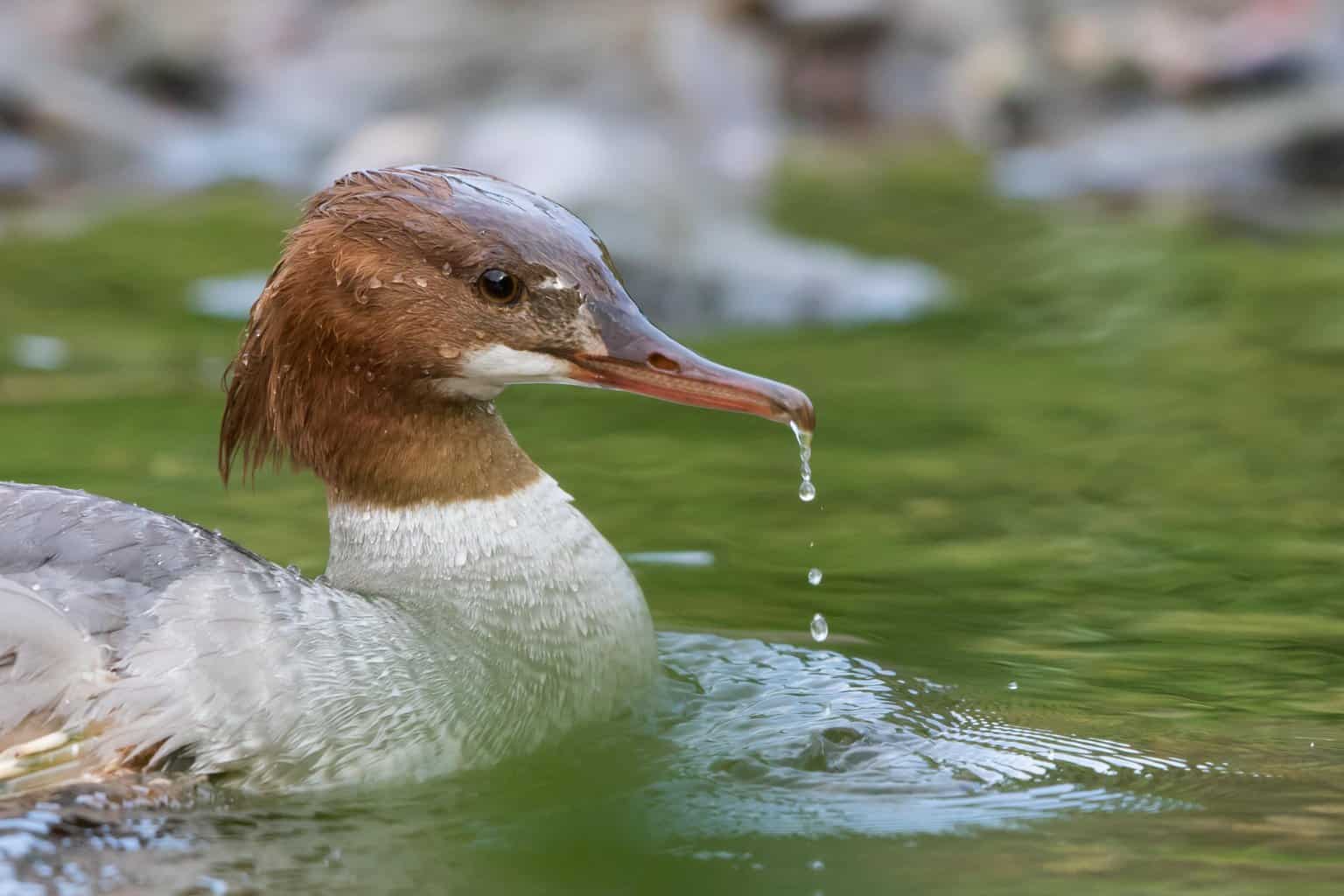
- Mergus Merganser
- Length: 21.3-27.9 inches
- Weight: 31.8-76.2 ounces
- Wingspan: 33.9 inches
These large ducks feature a striking green head and a sleek, orange bill on the males, with females sporting a similar bill against a red-brown head with a crest on the back.
Their bill is much more slender than most ducks on this list. When you see that long, orange bill, it’s usually a dead giveaway that it’s either the common merganser or the less common red-breasted merganser, up next on the list.
You’ll see common mergansers across midwestern rivers and lakes in the winter, diving underwater to catch fish.
Red-breasted Merganser
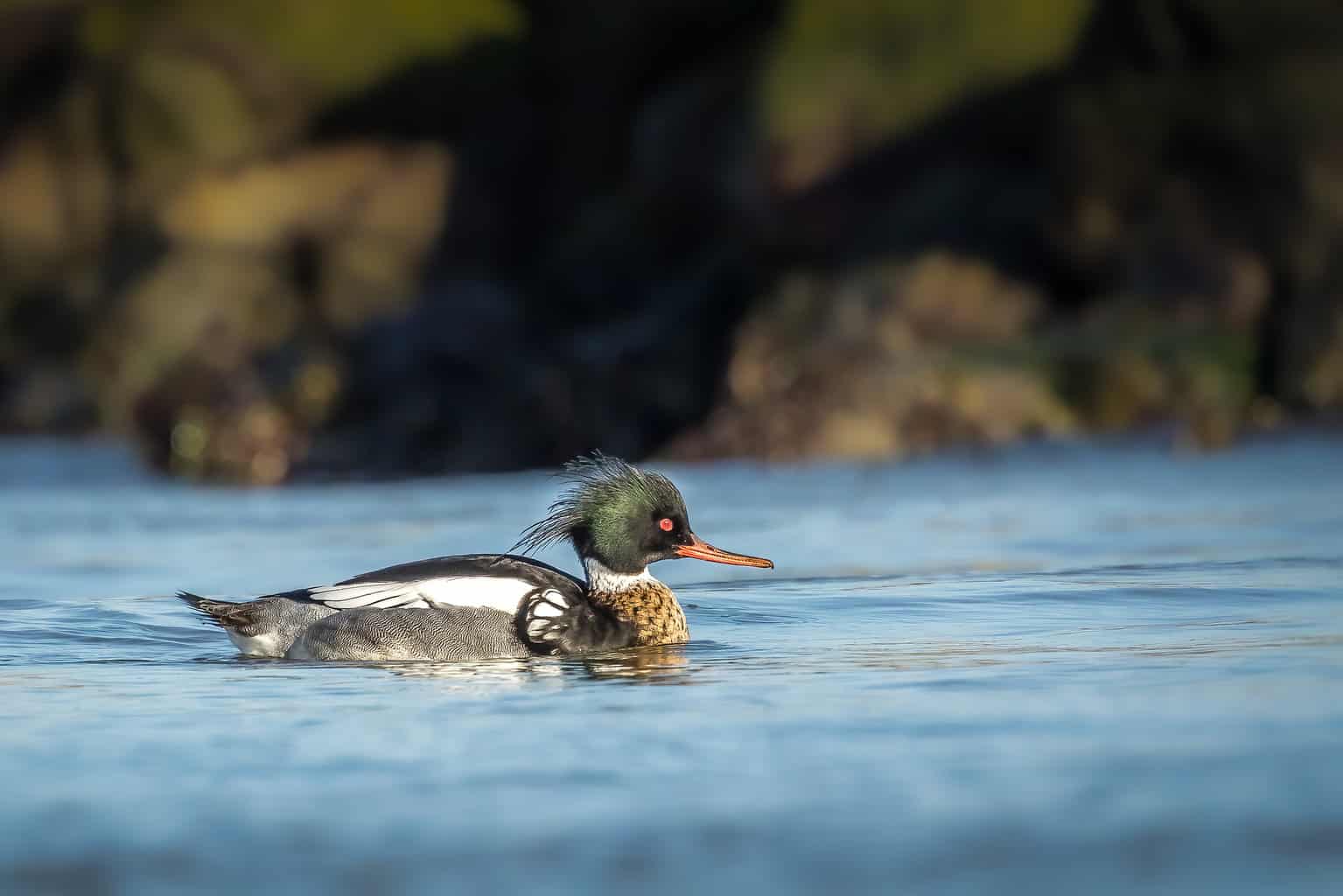
- Mergus Serrator
- Length: 20.1-25.2 inches
- Weight: 28.2-47.6 ounces
- Wingspan: 26-29.1 inches
Red-breasted mergansers are less common in Iowa, with sporadic sightings of these far-northern ducks in the Hawkeye State.
Male red-breasted mergansers have black heads and brown breasts. Their spiky black top of the head also sets them apart from the slick common merganser male.
Females have a head that is more dull-colored than the female common merganser.
Hooded Merganser
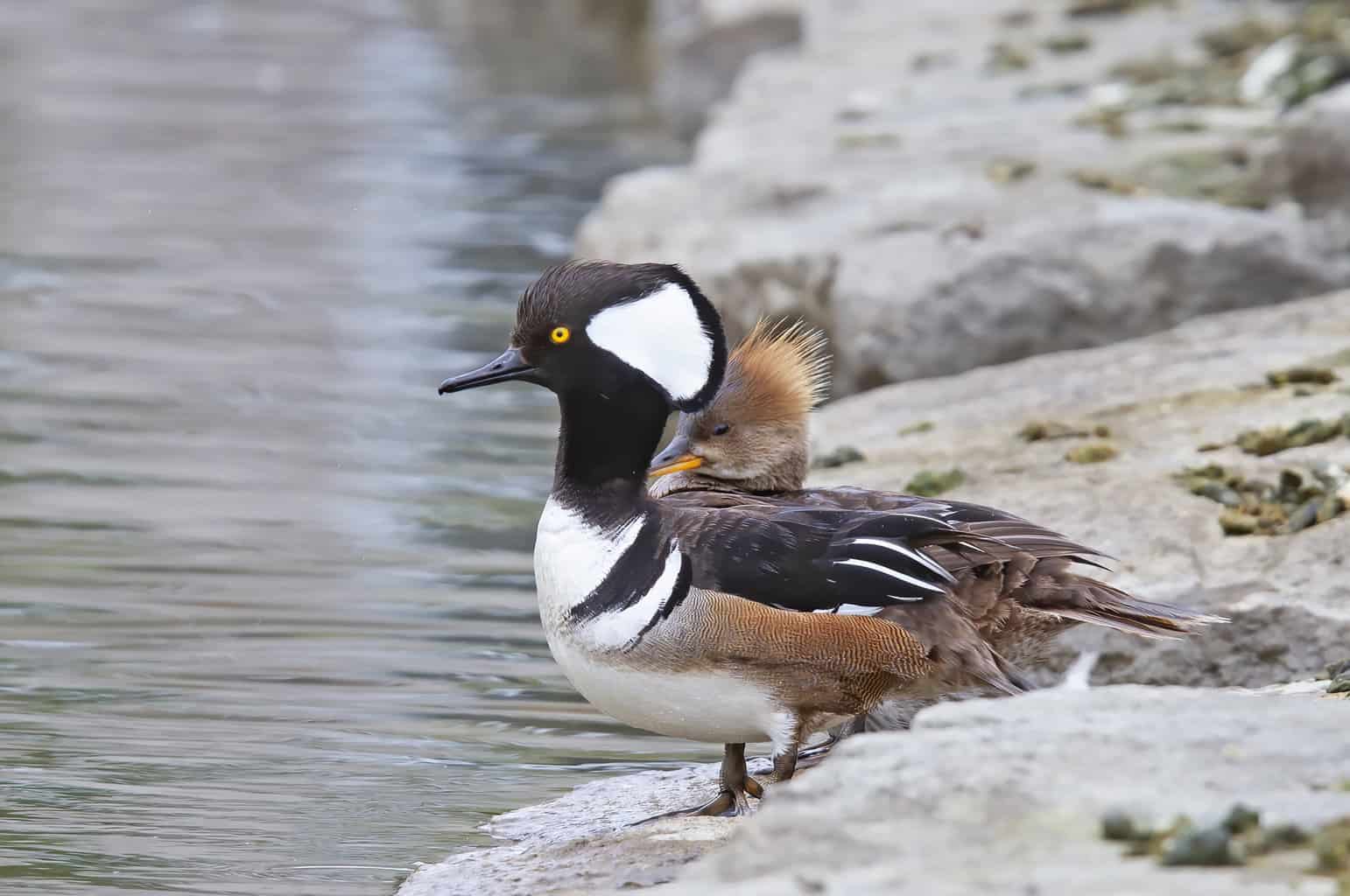
- Lophodytes Cucullatus
- Length: 15-8.-19.3 inches
- Weight: 16-31 ounces
- Wingspan: 23.6-26 inches
The final duck on our list is a unique one. The hooded merganser’s large crest makes this duck look like a bobblehead, with a head too big for its body.
They’re generally noticeably smaller than the two other mergansers we’ve mentioned, but the head doesn’t lack in size.
The male’s black head is interrupted by a big white patch on the back end that comes to a point at a yellow eye.
Their side is a cinnamon brown with a black backside and a white breast.
Females have the same large head, except brown and without the distinct white patch. Their body is a grayish-brown mix.
Hooded mergansers may breed in Iowa. They’re cavity nesters, so look out for them in wetlands with nearby trees, or in nest boxes.

